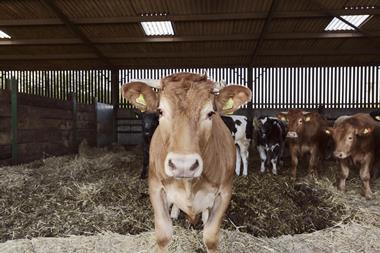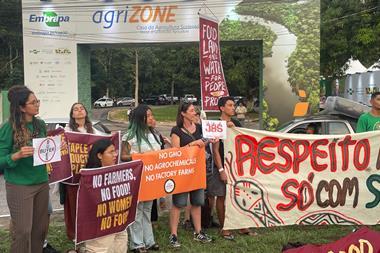Sheepmeat and pork production volumes hit hardest by foot and mouth epidemic
Abattoirs hit harder by FMD crisis than by BSE
Retailers and meat product manufacturers seem assured of more abundant domestic raw material supplies this year as the UK authorities continue relaxing livestock movement controls imposed during FMD.
But breeding cycles and structural problems in the primary processing industry suggest the market will remain deeply troubled.
Sharply reduced slaughterings of cattle, sheep and pigs caused chaos immediately after the disease was discovered in February last year, and the national kill is still significantly lower than abattoir operators regard as normal.
As the chart shows, sheepmeat and pork production volumes were hit hardest.
Pig slaughterings, like the cattle kill, began a partial recovery quite quickly whereas slaughterhouse lamb throughput was still very low in the pre-Christmas trading period.
Defra's latest estimates, for November, put beef production down 8% from a year earlier and pork output 7% lighter. The sheepmeat shortfall was 32%, and 20% less edible offal was produced.
The kill data are widely interpreted as meaning FMD has hurt the abattoir operators more than the 1996 BSE crisis, because this time slaughterings of all three species have dropped without fully compensating increases in meat output values.
Although BSE wrecked the beef trade, it boosted the pig kill and lamb prices.
However, FMD has perhaps caused traders to forget earlier warnings of dangerous supply and price movements.
In January last year MLC's Market Outlook bulletins noted the underlying trend in the beef breeding herd was "expected to be downwards", in the sheep sector "the fall in breeding numbers could be accompanied by a relatively poor lambing percentage", and in the pig industry any slight recovery in slaughter stock numbers after the sharp contraction of the breeding herd would probably be offset by price pressures due to heavier supply on the continent and in North America.
{{MEAT }}
Close menu
- Home
- Retail & Wholesale
-
Products & Suppliers
- Back to parent navigation item
- Products & Suppliers
-
Product Categories:
- Back to parent navigation item
- Product Categories:
- Alcoholic drinks
- Bakery
- Cereals & breakfast
- Cheese
- Chicken & poultry
- Chocolate
- Confectionery
- Crisps, nuts & snacks
- Dairy
- Fish
- Fresh produce
- Frozen
- Household
- Meat
- Own Label
- Sauces & condiments
- Seasonal
- Soft drinks
- Vaping
- Vegan & plant-based
- World foods
- Suppliers
- People
- Reports & Data
-
Topics A-Z
- Back to parent navigation item
- Topics A-Z
-
Popular topics:
- Back to parent navigation item
- Popular topics:
- Cost of living crisis
- Crime
- Deposit Return Schemes
- Finance
- Government & Regulation
- Health
- Inflation
- Loyalty
- Marketing
- Mergers & Acquisitions
- New Product Development
- Sourcing
- Supply chain
- Sustainability & environment
- Technology
- Ultra Processed Foods
- Vaping
- A-Z all topics
- Content by type:
- Events
- Ask iA (beta)
- Subscribe now
Sign in to comment on this article
Not logged in before? Register for FREE guest access today.
You will be able to:
- Read more stories
- Receive daily newsletters
- Comment on stories
Advert
















No comments yet